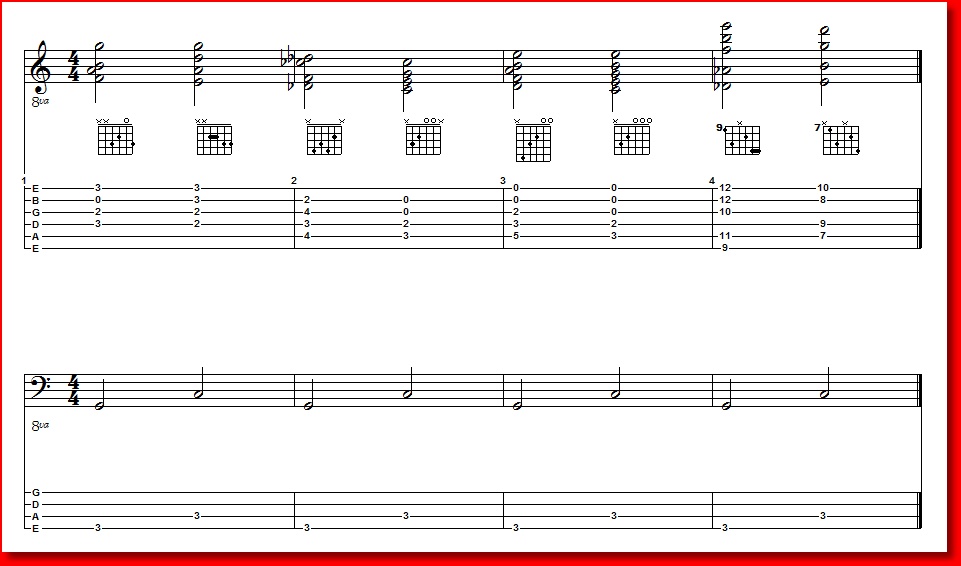
Appendix VI - Lesson 10
Altered Chords
Notes to Appendix VI - Lesson 10
Let's reminisce a bit. Can you remember your thoughts when you got to Volume 1's Lesson 2 and discovered V13b5b9 chord? Not only was it a big name, but also a big chord, covering five strings. It wasn't so difficult to play as it looks like a barred 7 chord with those two notes added by the pinkie. After more than a year, we can play it anywhere on the fretboard with as much ease as any chord.
Here in Appendix VI - Lesson 10, Mickey has finally given that chord a title - an "altered chord". Perhaps you came up with that name a long time back, or perhaps you're saying "so what?"
Well, the "what" is that it gives us quite a bit of choices over the normally built chords from a Major or minor scale. In addition to Major, dominant, and minor 7, 9, 11, and 13 chords, we can flat or sharp the 5th and 9th. We can sharp the 11 (which would be the same note as a b5) if we include the 5. We can add the 13 to a triad and call it a 6 chord. In fact, we can add both a 9 and 13 to a triad and call it a 6/9 chord.
All this flexibility causes another problem: we can have multiple name possibilities for the same group of notes. We give chords names basically to talk about them rather than play them. It's easier to tell your rhythm guitarist "give me 2 bars of G7" than to write out a manuscript (assuming, of course, he can read it!). I once heard someone ask a very fine jazz guitarist "what is that chord?" The guitarist answered "I don't know, I just play it, not talk about it."
There are as many naming systems for chords as there are players playing them. Coming up with a one-size-fits-all system is probably as futile as herding cats, or Jazz guitarists. Since we're using Mickey's courses, we've standardized somewhat our naming system. But once you go out on your own, your own experiences will mold your terminology.
Guitarists have limitations as to playing chords. Pick style players must strum through a chord and deaden unused strings. Fingerstyle players can do that with either their thumbs or a finger, or can pluck simultaneously up to 4 notes (assuming that the RH pinkie isn't used.) Musicologists say that for a 4-note chord of chords of 5 to 7 notes, the 3 and 7 are absolutely essential. The 3 gives the chord the major or minor flavor and the 7 determines if it's built around a Major, minor, or dominant 7. A 4-note 13 chord should have a 3, 7, 9 and 13.
Exercise 23 comprises four measures of V - I resolutions using altered chords. Mickey has written the notes in close spaced clusters as one might find on a master score for a sax or horn section in an orchestra. These aren't meant to be played on the guitar as written. I've re-written this exercise using guitar friendly chords of the same flavor. Also, I've added a bass part to play the V - I roots for us:

Exercise 23, Re-fingered Guitar Part and Added Bass Line
Exercise 23, 1st measure: Mickey gives us a third inversion G9 chord as its V. The chord listed as a C6/9 is actually a C Maj13 because the chord has the 7. Remove the B note and it is a true C6/9. In my edited version, I've used two common chord forms above the bass line.
Exercise 23, 2nd measure: The V chord here is a G7b5b9 chord. Wait a minute! We haven't studied that chord, we studied a G13b5b9, right? What are the notes from the root upwards? G - B - Db - F - Ab. Let's let our bass player play the root or G, and we'll play the rest: B, Db, F, and Ab. Let's now juggle those notes and what do we find? Db - F - Ab - B (actually Cb). That's a Db7 chord. A little light is probably coming on, after remembering all through the Volume 1 lessons, we learned that the chords a tri-tone (either a #4 or a b5) away freely substitute. Db is the tri-tone of G. Why does this work? Simple- the 3 of one chord is the 7 of the other and the 7 is the 3. Note I've used a simple Db7 to a C Maj7 in the edited version. Any time we see a V7b5b9 chord name, we can use a dominant 7 of the tri-tone.
Exercise 23, 3rd measure: G13 to C Maj7. No real surprises there. The guitar's V13 is a D min triad with the open 1st and 2nd strings. We can also look at the I chord as a C Maj triad with the open 1st and 2nd strings, or D min to C Maj.
Exercise 23, 4th measure: G13b5b9 to a C Maj9. Our old friend the V13b5b9 chord resolving to a C Maj9. For the guitar's I9 chord, I've used another old friend, the E min7 chord, just as we talked about in Lessons 18, 19, and Appendix VI - Lesson 9.
All of these sound very definitely like V to I, don't you think? And with the color, they all seem really familiar, either from our playing of them or remembering the playing of others.
Continue with the stretching exercises of the earlier lessons and your on-going re-harmonization of the classics.
As always, make it FUN!!